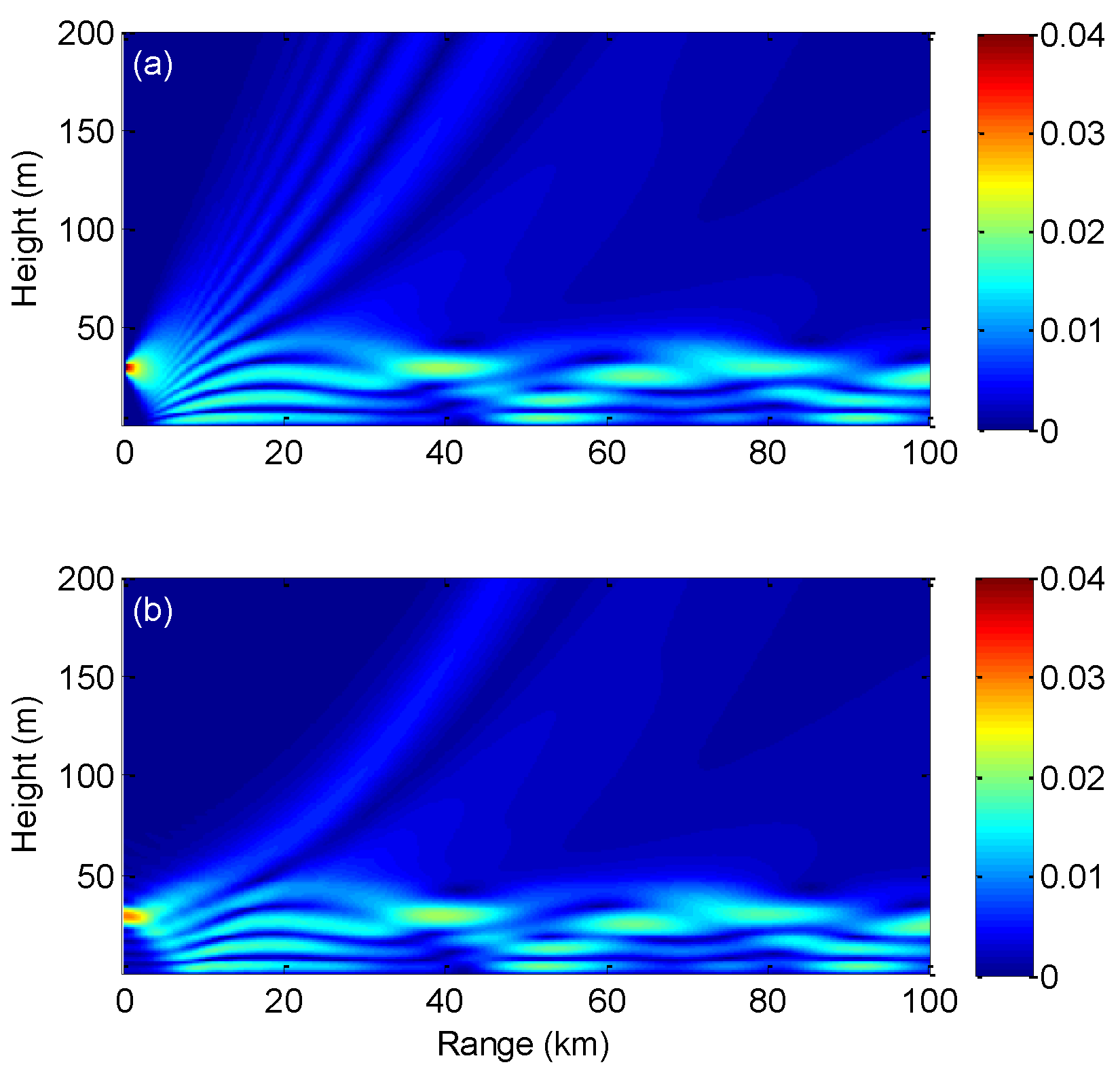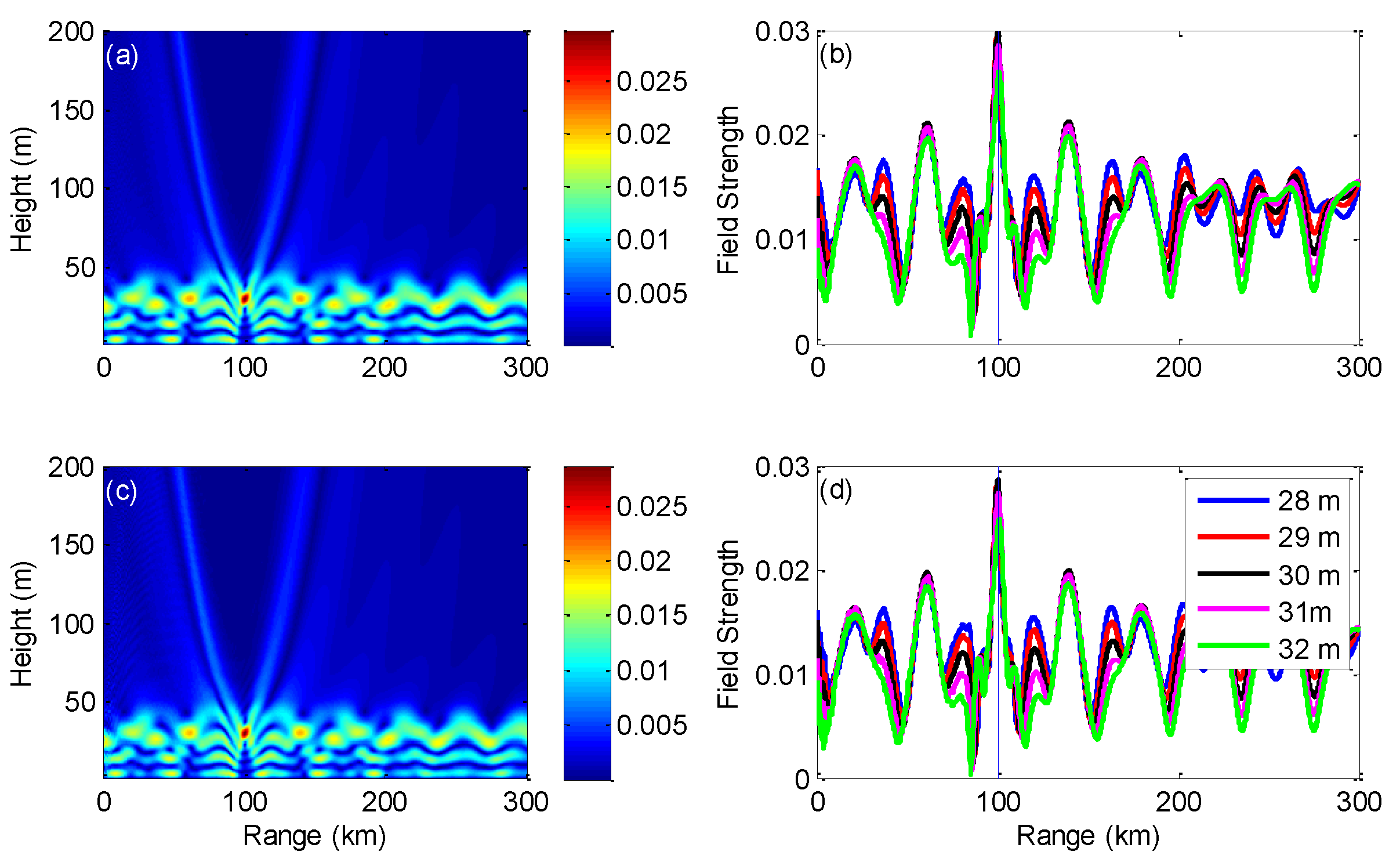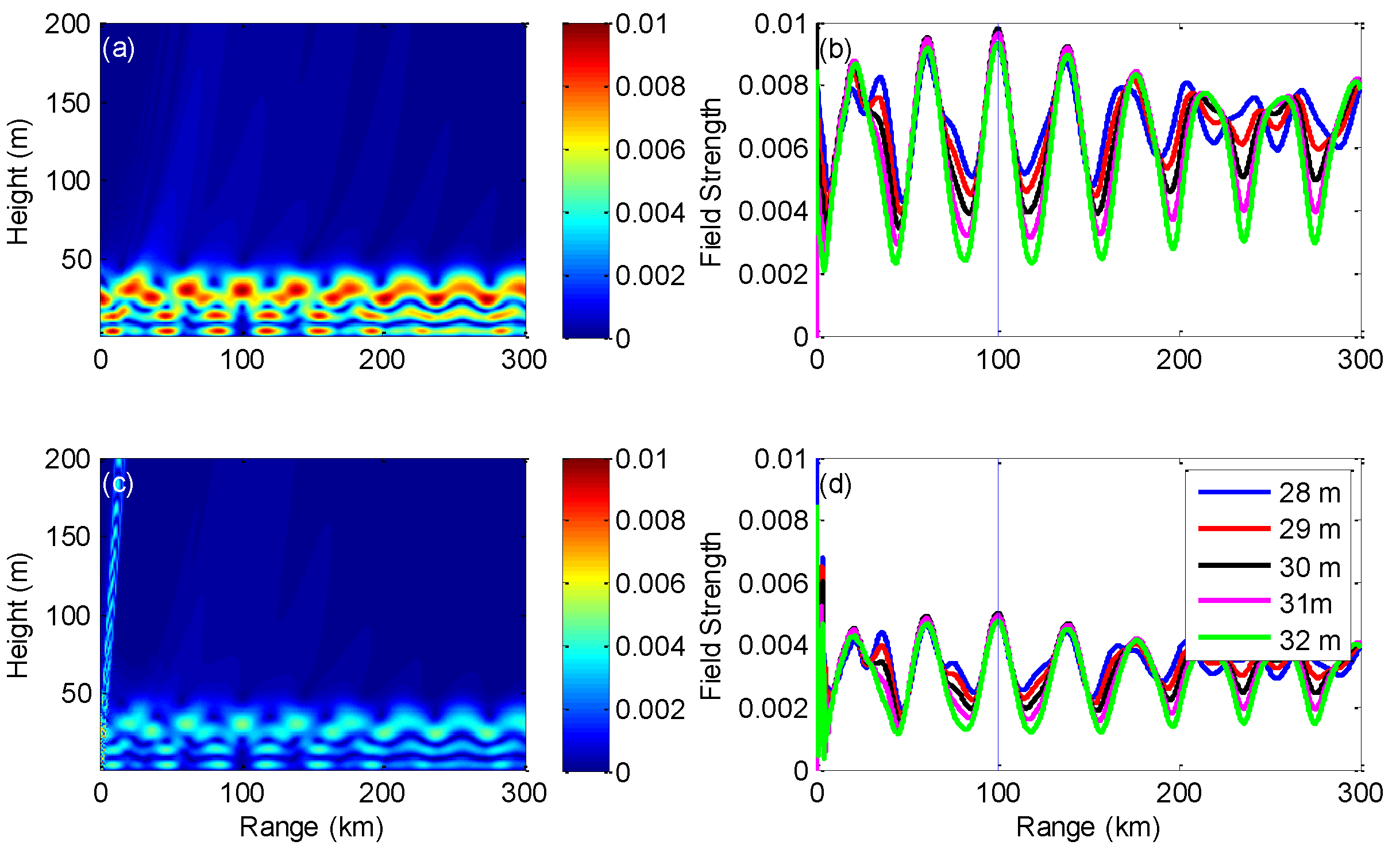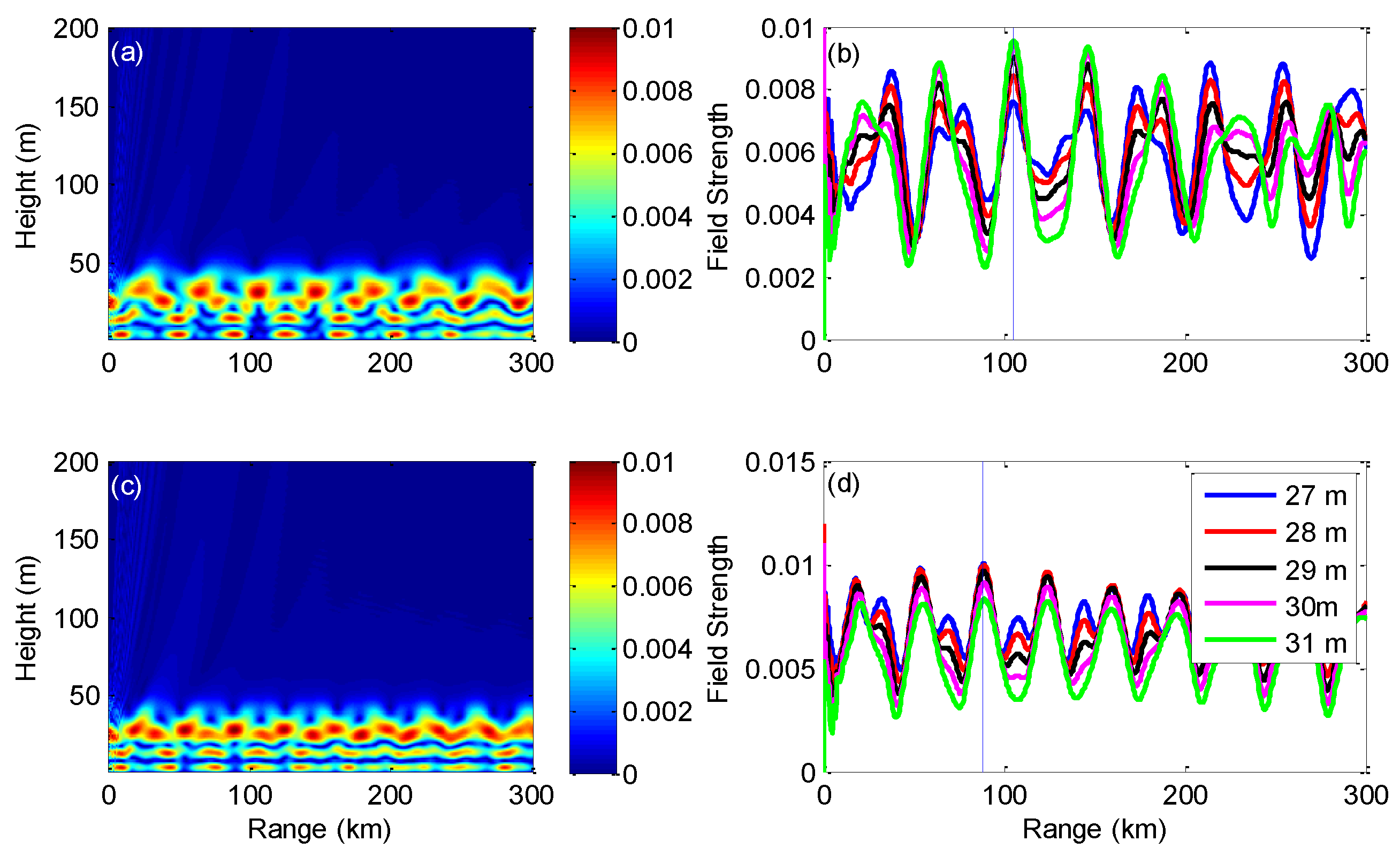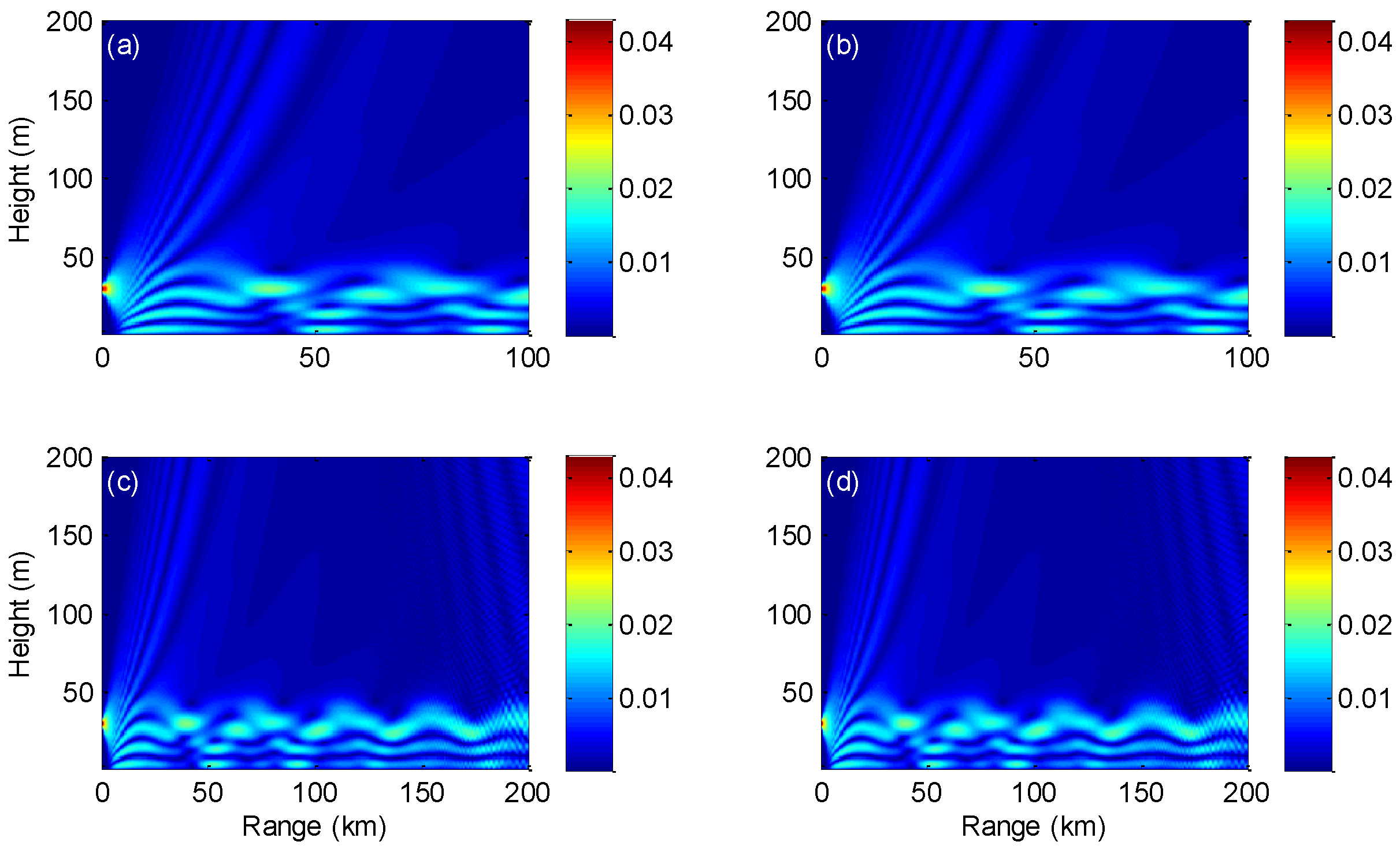The approach described above is novel in that it introduces the backward propagation of the adjoint integration for the source localization problem. With this method, an appropriate cost function by matching the observed signals with the predicted fields is not needed, and the repeated computations of the forward propagation model are avoided. Owing to the real data are not available, numerical experiments are performed to test the theoretical method.
In the following numerical computations, the refractive conditions are assumed to be horizontally homogeneous with a 50-m surface-based duct. A horizontal polarized Gaussain source located at a height of 30 m above the mean sea level is used to simulate the initial field at
x0 = 0. The detailed refractivity parameters and the source system parameters are shown in
Table 1 and
Table 2, respectively. These parameters are used as the input for the PE model to construct the synthetic measurements received by a vertical array at the range 100 km. That is, to the mean sea level of the receiver array, the source location can be noted as (range, height) = (100 km, 30 m).
4.1. Propagation Fields Reconstruction
Figure 1a gives the coverage diagram of the field strength
,
i.e., the absolute value of
, computed by the forward PE model(see Equation(2)). The computation domain is set to be: the maximum range 100 km, the range bin 200 m, the maximum height 1024 m, and the height bin 1 m (that is, the FFT transform size is 1024 = 2
10). It is seen that, owing to the duct propagation, most of the EM energy is captured in the duct layer. The focus center of the field strength is at the source location and the strength behaves, cyclical downswing, with the increment of the propagation range.
In the backward adjoint propagation modeling, the refractivity profile is assumed to be known. Set the synthetic field at the terminal range, 100 km, as the input to the adjoint model, the fields at previous ranges are computed in
Figure 1b. Comparing
Figure 1a with
Figure 1b, the basic propagation characteristics of the forward fields are reconstructed by the adjoint fields, but the whole field strength is weakened slightly. This is because in the forward and adjoint modeling, the upper one-fourth of the field is filtered to prevent reflections from the nonphysical upper boundary. However, the maximum field strength point can still be easily found around the source location.
Figure 1.
Coverage diagrams of the field strength. (a) Forward propagation modeling of the PE model, and (b) backward propagation modeling of the adjoint of the PE model.
Figure 1.
Coverage diagrams of the field strength. (a) Forward propagation modeling of the PE model, and (b) backward propagation modeling of the adjoint of the PE model.
The propagation field reconstructions without an additive filtering window are shown in the
appendix, where it can be seen that the forward propagation fields can be exactly reconstructed by the backward adjoint integration.
In practical operations, the available measurements are often contaminated by noise, and data with such high vertical resolutions are impossible. In the following, the influences of the noise and the receiver geometry to the localization results are considered.
4.2. Noise Influence
This section considers the influence of the measurement noise to the source localization results. Here, the vertical receiver array still contains 1024 elements with height interval of 1 m, but different random white noise is added to the received EM signals, as well as the impossible uncertainty of the refractivity measurement is also considered.
In case of the refractivity is exactly known,
Figure 2a gives the backward propagation fields with 15% random white noise added to the EM measurements, where the range of the receiver array is noted as 0 m and the backward propagation range is extended to 300 km. From
Figure 2a, it is clear that the maximum field strength appears around (100 km, 30 m). According to the above analysis, the position of the maximum strength corresponds to the source location. Additionally, it is seen that above the source location exists as a big “V” blind energy zone that is caused by the directional transmitting source and the size of ‘V’ is determined by the 3 dB beamwidth. Moreover, there exists a reverse ‘V’ blind energy zone below the source location. Although similar zones also exist at ranges of 65 km and 135 km, the shape at a range of 100 km is clearer. Near the vertical receiver array, the reconstructed field looks a little blurry, which is caused by the EM measurement noise.
Figure 2b shows the field strength along the propagation range at different heights, which further validates the source localization results.
Figure 2c,d gives the backward propagation fields with 30% additive random white noise. The source location can still be easily found from the coverage diagram, but the fields near the vertical receiver array look more blurry than in
Figure 2a, owing to the more noisy EM measurements.
Figure 2.
The influences of the EM measurement noise to the source localization results. (a) Coverage diagram of the backward propagation field with 15% random white noise added to the EM measurements, (b) the field strength along the propagation range at different heights of (a), (c) and (d) are, respectively, identical to (a) and (b), but with 30% additive random white noise.
Figure 2.
The influences of the EM measurement noise to the source localization results. (a) Coverage diagram of the backward propagation field with 15% random white noise added to the EM measurements, (b) the field strength along the propagation range at different heights of (a), (c) and (d) are, respectively, identical to (a) and (b), but with 30% additive random white noise.
Figure 3.
The influences of the refractivity measurement noise to the source localization results. (a) Coverage diagram of the backward propagation field with duct height of 55 m and duct strength of 10 M-units, (b) the field strength along the propagation range at different heights of (a), (c) and (d) are, respectively, identical to (a) and (b), but with duct height of 50 m and duct strength of 12 M-units.
Figure 3.
The influences of the refractivity measurement noise to the source localization results. (a) Coverage diagram of the backward propagation field with duct height of 55 m and duct strength of 10 M-units, (b) the field strength along the propagation range at different heights of (a), (c) and (d) are, respectively, identical to (a) and (b), but with duct height of 50 m and duct strength of 12 M-units.
In practical operations, it is difficult to absolutely exactly ensure the refractivity measurements. Refractivity measurement noise will inevitably influence the source localization results. Maintaining 30% random white noise added to the EM measurements,
Figure 3a shows the backward propagation fields with a 55-m duct height and 10 M-units of duct strength (
i.e., 5 m higher than the true duct height).It is clear that, in the first 100 km propagation range, the field strengthlooks very blurry, and the big “V” and reverse “V” blind energy zones shift off 100 km range to some extent. With the aid of field strength along the propagation range in
Figure 3b, the maximum energy point,
i.e., source position can be determined at 105 km, 32 m.
Figure 3c gives the backward propagation fields with a 50-m duct height and 12 M-units of duct strength (
i.e., 2 M-units stronger than the true duct strength). Compared with
Figure 3a, the reverse ‘V’ blind energy zone nearly disappears in
Figure 3c and the maximum energy point deviates over 10 km away from the true source position. Combining
Figure 3c with
Figure 3d, the estimated location is 87 km, 27 m. Although the change of duct height is larger than the duct strength (both increase by 10%, respectively), the localization result of duct height departure is better than that of duct strength departure. This may be due to the fact that, in the duct propagations, EM energy distribution depends more on duct strength than on duct height.
4.3. Receiver Geometry Influence
The influence of the receiver geometry to the source localization results is considered in this section. Two different geometries are used. In Case 1, the transmitted signal is received by a vertical array of 25 elements uniformly distributed between 2 m and 50 m. In Case 2, the same number receivers are uniformly distributed between 4 m and 100 m. In the following,
Figure 4 gives the results without noise, and
Figure 5 gives the results with both EM measurement noise and refractivity uncertainties.
Figure 4.
The influences of the receiver geometry to the source localization results. (a) Coverage diagram of the backward propagation field with Case 1 geometry, (b) the field strength along the propagation range at different heights of (a), (c), and (d) are, respectively, identical to (a) and (b), but with Case 2 geometry.
Figure 4.
The influences of the receiver geometry to the source localization results. (a) Coverage diagram of the backward propagation field with Case 1 geometry, (b) the field strength along the propagation range at different heights of (a), (c), and (d) are, respectively, identical to (a) and (b), but with Case 2 geometry.
Figure 4a gives the backward propagation fields with 2–50 m receiver geometry. Due to lacking of the enough received signals, the source location is not easily determined, as shown in
Figure 2. From the energy-focused districts, it is certain that the source height is around 30 m, but there exist several local maximum energy points. To determine the source location exactly, the field strength along the propagation range shown in
Figure 4b will be helpful. Combining
Figure 4a with
Figure 4b, the source location can be fixed at 100 km, 30 m, by selecting the middle one among the three local maximum values. The reverse “V” shape blind energy zone in
Figure 4a can also give an assistance to validate the localization results.
Figure 4c,d gives the backward propagation fields with 4–100 m receiver geometry. The field strength with this geometry looks like only half that of Case 1. This is because the energy above the duct height (50 m) contributes slightly to the duct layer propagation. The singular highlight fields near the receiver array may be caused the sparse received signals. These abnormal fields should be ignored for the localization results. Combining
Figure 4c with
Figure 4d, the source location can also be exactly determined with the same analysis method.
Figure 5 shows the backward propagation fields with 2–50 m receiver geometry, combining 30% EM measurement noise with refractivity uncertainties (the same as the refractivity changes in
Figure 3). Again, with refractivity noise, the estimated source position does not match very well with the true source point. With 10% duct height increment, see
Figure 5a,b, the maximum energy point can be determined at 105 km, 31 m; while with 10% duct strength increment, see
Figure 5c,d, the maximum energy point can be determined at 88.5 km, 27 m. Comparing
Figure 4 and
Figure 5 with
Figure 2 and
Figure 3, it is found that, although getting unabridged received signals is not necessary, the decrease of the receiver number increases the difficulty of finding the maximum energy point. If receiver numbers are dropped further, it will make the localization results more inconclusive.
Figure 5.
The influences of the receiver geometry (Case 1) and measurement noise to the source localization results. (a) Coverage diagram of the backward propagation field with duct height of 55 m and duct strength of 10 M-units, (b) the field strength along the propagation range at different heights of (a), (c) and (d) are, respectively, identical to (a) and (b), but with a duct height of 50 m and duct strength of 12 M-units.
Figure 5.
The influences of the receiver geometry (Case 1) and measurement noise to the source localization results. (a) Coverage diagram of the backward propagation field with duct height of 55 m and duct strength of 10 M-units, (b) the field strength along the propagation range at different heights of (a), (c) and (d) are, respectively, identical to (a) and (b), but with a duct height of 50 m and duct strength of 12 M-units.
